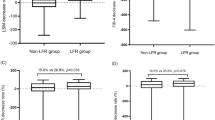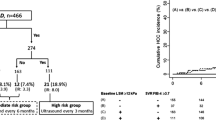Abstract
Background
Short-time usage of direct-acting antiviral agents (DAA) limited knowledge regarding histological outcomes and predictive values of noninvasive measurements in patients with hepatitis C virus (HCV) after sustained virologic response (SVR) with DAA.
Aims
This study aimed to indicate histological changes and assess predictive value of noninvasive measurements for fibrosis in these patients.
Methods
HCV patients who achieved SVR by DAA were identified. Pre- and post-SVR clinical and histological data were collected.
Results
Of patients, 83% (33/40), 38% (15/40) and 83% (33/40) achieved inflammation improvement, fibrosis regression and histological improvement, respectively. Liver stiffness measurements (LSM), APRI, and FIB-4 could predict post-SVR fibrosis well without significant differences. Areas under receiver operating characteristic curves of LSM, APRI, and FIB-4 were 0.78, 0.81, and 0.87 for post-SVR advanced fibrosis (≥ F4) and 0.86, 0.86, and 0.85 for post-SVR cirrhosis (≥ F5), respectively. Pre-SVR LSM, APRI, and FIB-4 values were significantly lower in patients with fibrosis regression (P = 0.003–0.012), while FIB-4 was significantly lower in patients with histological improvement (P = 0.012–0.033). Patients with higher pre-SVR Ishak scores tended to have bigger decline in APRI (P = 0.025) and FIB-4 (P = 0.024) after SVR.
Conclusions
DAA could improve liver inflammation and fibrosis of HCV patients in a short time after SVR. LSM, APRI, and FIB-4 predict fibrosis well even after SVR by DAA. Most of the cutoff values for advanced fibrosis (≥ F4) and cirrhosis (≥ F5) of these noninvasive measurements decreased significantly after SVR, maybe because of the inflammation improvement.



Similar content being viewed by others
References
Blach S, Zeuzem S, Manns M, et al. Global prevalence and genotype distribution of hepatitis C virus infection in 2015: a modelling study. Lancet Gastroenterol Hepatol. 2017;2:161–176.
McHutchison JG, Gordon SC, Schiff ER, et al. Interferon alfa-2b alone or in combination with ribavirin as initial treatment for chronic hepatitis C. Hepatitis Interventional Therapy Group. N Engl J Med. 1998;339:1485–1492.
George SL, Bacon BR, Brunt EM, Mihindukulasuriya KL, Hoffmann J, Di Bisceglie AM. Clinical, virologic, histologic, and biochemical outcomes after successful HCV therapy: a 5-year follow-up of 150 patients. Hepatology. 2009;49:729–738.
Whitcomb E, Choi WT, Jerome KR, et al. Biopsy specimens from allograft liver contain histologic features of hepatitis C virus infection after virus eradication. Clin Gastroenterol Hepatol. 2017;15:1279–1285.
Enomoto M, Ikura Y, Tamori A, et al. Short-term histological evaluations after achieving a sustained virologic response to direct-acting antiviral treatment for chronic hepatitis C. United Eur Gastroenterol J. 2018;6:1391–1400.
Watanabe T, Tokumoto Y, Joko K, Michitaka K, Horiike N, Tanaka Y, et al. Predictors of hepatocellular carcinoma occurrence after direct-acting antiviral therapy in patients with hepatitis C virus infection. Hepatol Res. 2019;2:136–146.
Giannini EG, Crespi M, Demarzo M, et al. Improvement in hepatitis C virus patients with advanced, compensated liver disease after sustained virological response to direct acting antivirals. Eur J Clin Invest. 2019;3:e13056.
Ravaioli F, Conti F, Brillanti S, et al. Hepatocellular carcinoma risk assessment by the measurement of liver stiffness variations in HCV cirrhotics treated with direct acting antivirals. Dig Liver Dis. 2018;50:573–579.
Alem SA, Said M, Anwar I, et al. Improvement of liver stiffness measurement, acoustic radiation force impulse measurements, and noninvasive fibrosis markers after direct-acting antivirals for hepatitis C virus G4 recurrence post living donor liver transplantation: egyptian cohort. J Med Virol. 2018;90:1508–1515.
Chan J, Gogela N, Zheng H, et al. Direct-acting antiviral therapy for chronic HCV infection results in liver stiffness regression over 12 months post-treatment. Dig Dis Sci. 2018;63:486–492. https://doi.org/10.1007/s10620-017-4749-x.
Pan JJ, Bao F, Du E, et al. Morphometry confirms fibrosis regression from sustained virologic response to direct-acting antivirals for hepatitis C. Hepatol Commun. 2018;2:1320–1330.
Wai CT, Greenson JK, Fontana RJ, et al. A simple noninvasive index can predict both significant fibrosis and cirrhosis in patients with chronic hepatitis C. Hepatology. 2003;38:518–526.
Sterling RK, Lissen E, Clumeck N, et al. Development of a simple noninvasive index to predict significant fibrosis in patients with HIV/HCV coinfection. Hepatology. 2006;43:1317–1325.
Brunt EM. Grading and staging the histopathological lesions of chronic hepatitis: the Knodell histology activity index and beyond. Hepatology. 2000;31:241–246.
Bachofner JA, Valli PV, Kroger A, et al. Direct antiviral agent treatment of chronic hepatitis C results in rapid regression of transient elastography and fibrosis markers fibrosis-4 score and aspartate aminotransferase-platelet ratio index. Liver Int. 2017;37:369–376.
Knop V, Hoppe D, Welzel T, et al. Regression of fibrosis and portal hypertension in HCV-associated cirrhosis and sustained virologic response after interferon-free antiviral therapy. J Viral Hepat. 2016;23:994–1002.
Singh S, Facciorusso A, Loomba R, Falck-Ytter YT. Magnitude and kinetics of decrease in liver stiffness after antiviral therapy in patients with chronic hepatitis C: a systematic review and meta-analysis. Clin Gastroenterol Hepatol. 2018;16:27–38.e24.
Facciorusso A, Del Prete V, Turco A, Buccino RV, Nacchiero MC, Muscatiello N. Long-term liver stiffness assessment in hepatitis C virus patients undergoing antiviral therapy: results from a 5-year cohort study. J Gastroenterol Hepatol. 2018;33:942–949.
Haseltine EL, Penney MS, George S, Kieffer TL. Successful treatment with telaprevir-based regimens for chronic hepatitis C results in significant improvements to serum markers of liver fibrosis. J Viral Hepat. 2015;22:701–707.
Hsu WF, Lai HC, Su WP, et al. Rapid decline of noninvasive fibrosis index values in patients with hepatitis C receiving treatment with direct-acting antiviral agents. BMC Gastroenterol. 2019;19:63.
Arena U, Vizzutti F, Abraldes JG, et al. Reliability of transient elastography for the diagnosis of advanced fibrosis in chronic hepatitis C. Gut. 2008;57:1288–1293.
Dolmazashvili E, Abutidze A, Chkhartishvili N, Karchava M, Sharvadze L, Tsertsvadze T. Regression of liver fibrosis over a 24-week period after completing direct-acting antiviral therapy in patients with chronic hepatitis C receiving care within the national hepatitis C elimination program in Georgia: results of hepatology clinic HEPA experience. Eur J Gastroenterol Hepatol. 2017;29:1223–1230.
Elsharkawy A, Eletreby R, Fouad R, et al. Impact of different sofosbuvir based treatment regimens on the biochemical profile of chronic hepatitis C genotype 4 patients. Expert Rev Gastroenterol Hepatol. 2017;11:773–778.
Castera L, Forns X, Alberti A. Non-invasive evaluation of liver fibrosis using transient elastography. J Hepatol. 2008;48:835–847.
Coco B, Oliveri F, Maina AM, et al. Transient elastography: a new surrogate marker of liver fibrosis influenced by major changes of transaminases. J Viral Hepat. 2007;14:360–369.
Arena U, Vizzutti F, Corti G, et al. Acute viral hepatitis increases liver stiffness values measured by transient elastography. Hepatology. 2008;47:380–384.
Song ZZ. Re: transient elastography is unreliable for detection of cirrhosis in patients with acute liver damage. Hepatology. 2008;48:1351–1352.
de Ledinghen V, Vergniol J, Foucher J, Merrouche W, le Bail B. Non-invasive diagnosis of liver steatosis using controlled attenuation parameter (CAP) and transient elastography. Liver Int. 2012;32:911–918.
Guzelbulut F, Cetinkaya ZA, Sezikli M, Yasar B, Ozkara S, Ovunc AO. AST-platelet ratio index, Forns index and FIB-4 in the prediction of significant fibrosis and cirrhosis in patients with chronic hepatitis C. Turk J Gastroenterol. 2011;22:279–285.
Fujita K, Kuroda N, Morishita A, et al. Fibrosis staging using direct serum biomarkers is influenced by hepatitis activity grading in hepatitis C virus infection. J Clin Med. 2018;7:267.
Lee YA, Friedman SL. Reversal, maintenance or progression: what happens to the liver after a virologic cure of hepatitis C? Antivir Res. 2014;107:23–30.
Putra J, Schiano TD, Fiel MI. Histological assessment of the liver explant in transplanted hepatitis C virus patients achieving sustained virological response with direct-acting antiviral agents. Histopathology. 2018;72:990–996.
Chu CY, Cheng CH, Chen HL, Lin IT, Wu CH, Lee YK, et al. Long-term histological change in chronic hepatitis C patients who had received peginterferon plus ribavirin therapy with sustained virological response. J Formos Med Assoc. 2019;7:1129–1137.
Pockros PJ, Hamzeh FM, Martin P, et al. Histologic outcomes in hepatitis C-infected patients with varying degrees of virologic response to interferon-based treatments. Hepatology. 2010;52:1193–1200.
Veldt BJ, Saracco G, Boyer N, et al. Long term clinical outcome of chronic hepatitis C patients with sustained virological response to interferon monotherapy. Gut. 2004;53:1504–1508.
Toccaceli F, Laghi V, Capurso L, Koch M, Sereno S, Scuderi M. Long-term liver histology improvement in patients with chronic hepatitis C and sustained response to interferon. J Viral Hepat. 2003;10:126–133.
Funding
This study was funded by National Natural Science Foundation of China [Grant Number: 81870406], China National Science and Technology Major Project for Infectious Diseases Control during the 13th Five-Year Plan Period [Grant Number: 2017ZX10202202] and Beijing Natural Science Foundation [Grant Number: 7182174].
Author information
Authors and Affiliations
Corresponding author
Ethics declarations
Conflict of interest
Lai Wei has received research support and/or consulting fees from AbbVie, Bristol-Myers Squibb, Roche, Novartis and Gilead, but none are relevant to this particular study. Rui Huang, Huiying Rao, Ming Yang, Yinghui Gao, Jian Wang, Qian Jin, and Danli Ma have no outside support, conflicts, or financial interests to disclose.
Ethical approval
All procedures performed in studies involving human participants were in accordance with the ethical standards of the institutional and/or national research committee and with the 1964 Helsinki declaration and its later amendments or comparable ethical standards. For this type of study, formal consent is not required.
Additional information
Publisher's Note
Springer Nature remains neutral with regard to jurisdictional claims in published maps and institutional affiliations.
Rights and permissions
About this article
Cite this article
Huang, R., Rao, H., Yang, M. et al. Noninvasive Measurements Predict Liver Fibrosis Well in Hepatitis C Virus Patients After Direct-Acting Antiviral Therapy. Dig Dis Sci 65, 1491–1500 (2020). https://doi.org/10.1007/s10620-019-05886-y
Received:
Accepted:
Published:
Issue Date:
DOI: https://doi.org/10.1007/s10620-019-05886-y




